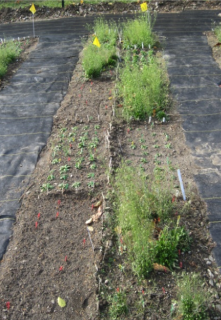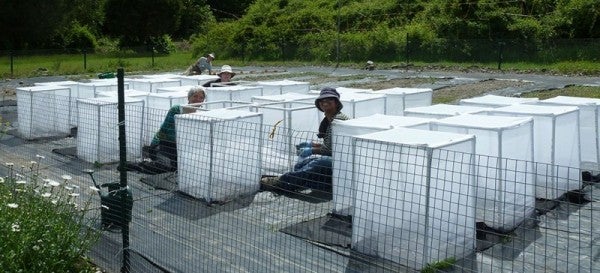My lab studies the ecological and genomic mechanisms of plastic responses and evolutionary adaptation to environmental change. We are interested in questions such as: What is the genetic basis of adaptive trait variation in the wild? Can information on the genetic basis of environmentally plastic traits allow us to predict trait expression in novel environments? How will natural selection act on the resulting phenotype in those environments? Can we predict how species will evolve or persist in the face of ongoing rapid environmental change?
We address these questions using the genomic toolbox of the annual weed Arabidopsis thaliana, combined with field experiments, controlled environmental manipulations, climate data, and modeling. The lab has recently moved to UC Davis, and over the next few years we will also be exploring research possibilities with other California plant species. Our ultimate goal is to develop a general framework to predict trait expression in novel environments and forecast patterns of population persistence and adaptive evolution in response to changing climate.
Current areas of investigation include:
The genetic basis of complex traits in natural environments:
We study the genetic basis of life history traits in natural environments, using field experiments with inbred lines from natural populations (ecotypes), recombinant inbred lines (RILs), and near-isogenic lines (NILs) in different seasons and geographic sites (Weinig et al. 2002, 2003a,b, Stinchcombe et al. 2004, 2009, Donohue et al. 2005 a,b,c, Korves et al. 2007, Huang et al. 2010, Fournier-Level et al. 2011, 2013). These data allow us to dissect the genetic basis of flowering time, life history expression, and fitness in different seasons and climates via quantitative trait locus (QTL) mapping, candidate gene associations, and genome-wide association studies (GWAS). We can thus examine the  causal paths from allelic variation to phenotype to fitness in different environments, and find (that the genetic basis of life history differs dramatically across different natural environments Fournier-Level et al. 2013). We combine our field experiments with controlled chamber manipulations of specific environmental factors to test functional hypotheses about the effects of allelic variation at specific candidate loci on life history expression in different climatic and seasonal environments. For example, we recently grew selected RILs in controlled chamber experiments simulating annual cycles of daylength daily temperature changes under different scenarios of predicted climate change. We are currently developing multilocus NILs to dissect the epistatic effects of different combinations of major flowering time QTL. We are also initiating experimental studies of gene expression to explore the effects of allelic variation within developmental signaling networks in different complex environments.
causal paths from allelic variation to phenotype to fitness in different environments, and find (that the genetic basis of life history differs dramatically across different natural environments Fournier-Level et al. 2013). We combine our field experiments with controlled chamber manipulations of specific environmental factors to test functional hypotheses about the effects of allelic variation at specific candidate loci on life history expression in different climatic and seasonal environments. For example, we recently grew selected RILs in controlled chamber experiments simulating annual cycles of daylength daily temperature changes under different scenarios of predicted climate change. We are currently developing multilocus NILs to dissect the epistatic effects of different combinations of major flowering time QTL. We are also initiating experimental studies of gene expression to explore the effects of allelic variation within developmental signaling networks in different complex environments.
Predicting life history expression in natural environments:
If we can identify the genetic basis of life history variation in natural conditions, can we then use this information to predict trait expression in novel environments? To this end, in collaboration with Stephen Welch at Kansas State University, we developed a genetically informed photothermal model to predict the flowering time of A. thaliana mutants impaired in different environmental signaling pathways in natural seasonal environments (Wilczek et al. 2009), recently refined by Chew et al. (2012). The approach is to model the daily developmental progress of each genotype from field environmental data on daylength, thermal time, and exposure to chilling, using functions that describe the ability of each genotype to respond to those signals. By manipulating the daily photothermal inputs into the model, we can do thought experiments to predict when any germination cohort of a given genotype will flower in different regions and seasonal climates, or predict how flowering time will change within a site or across the species native range under scenarios of future climate change (Wilczek et al. 2010). Our next objective is to generalize the model to predict effects of natural allelic variation at major flowering time loci on life history expression in different climates, and to explore the effects of perturbing gene function in different parts of the signaling network.
Another objective, in collaboration with former postdoc Kathleen Donohue and her lab at Duke University, is to develop an integrated model of life history expression and population dynamics in natural environments. Our photothermal model demonstrates that flowering time depends critically on germination timing in natural environments (Wilczek et al. 2009, 2010), and we also know that germination timing in the field in turn depends critically upon the timing of flowering and seed dispersal (Donohue et al. 2005), and can experience strong selection (Donohue et al. 2005, Huang et al. 2010). To predict the actual life history expression of different genotypes under field conditions requires an integrated life-cycle model of germination and flowering dynamics. Former postbac Liana Burghardt (now a Ph.D student in the Donohue lab), with Jessica Metcalf (Oxford), is developing such an integrated model for A. thaliana, combining a hydrothermal model of seed germination timing with a photothermal flowering model to predict life cycle dynamics of different genotypes in different climates. To complement this model, we conduct field experiments examining the effects of germination timing on life history expression in different genotypes. We are also now conducting a multigenerational cage experiment with selected RILs in our Rhode Island field site to study the life history expression and population dynamics of genotypes segregating different combinations of flowering and seed dormancy QTL alleles. We are now planning experiments in California to examine how changes in the timing, duration, and amount of winter rainfall affect life history expression and fitness of different genotypes in a Mediterranean climate. The ultimate goal is to create a genetically-informed process-based life cycle model to predict the geographic distribution and adaptive evolution of germination and time in current and future climates.
Understanding mechanisms of natural selection and local adaptation:
We have a long-standing interest in understanding the mechanisms of local adaptation (e.g. Dudley and Schmitt 1995, Donohue et al. 2000, Von Wettberg et al. 2008). Because A. thaliana is an inbreeding species, we can combine our field data with genotypes and phenotypic data for the same inbred lines from laboratory studies, as well as geographic and climatic data from the site of origin for ecotypes, to test for the signature of geographic adaptation. We find strong circumstantial evidence for climate adaptation in the form of latitudinal clines observed in common gardens (Stinchcombe et al. 2004, Hopkins et al. 2008), and are testing directly for climate matching using fitness data from ecotypes grown in field experiments across the species climate range. We can moreover test whether local adaptation to climate is lagging behind rapid recent climate change, an important question for forestry and conservation biology.
We are also interested in the ecological and genetic mechanisms underlying local adaptive evolution. Using genotypic selection analysis and structural equation modeling, we are now elucidating how natural selection acts on specific life history traits in different sites and seasons. Our field data also allow us to measure natural selection at specific loci in different natural environments. We do this by testing for fitness associations with candidate gene polymorphisms (Korves et al. 2007, Fournier-Level et al. 2013), as well as genomewide scans for fitness-associated SNPs (Fournier-Level et al. 2011). We can moreover use climate data from the site of ecotype origin to ask whether specific alleles occupy distinct climate niches, using climate envelope analysis tools used by landscape ecologists to predict species range limits (Fournier-Level et al. 2011, Banta et al. 2012). We find that entirely different loci are most strongly associated with fitness in each field site. Moreover, the alleles associated with fitness in each site are significantly more differentiated in climate space than genomic controls, suggesting that they may contribute to climatic adaptation. Thus, by combining our field fitness data with climatic information and genomic data for the same ecotypes, we can begin to dissect the underlying genetic mechanisms of local adaptation.